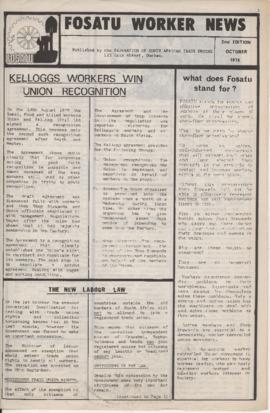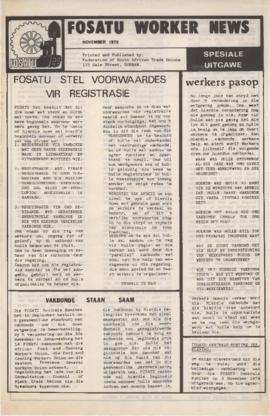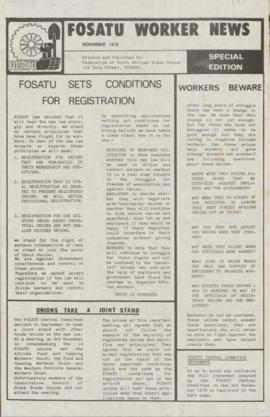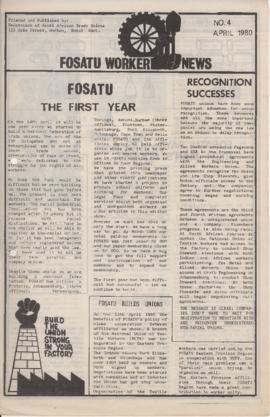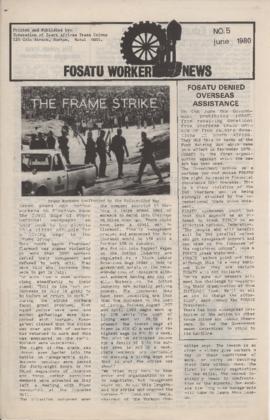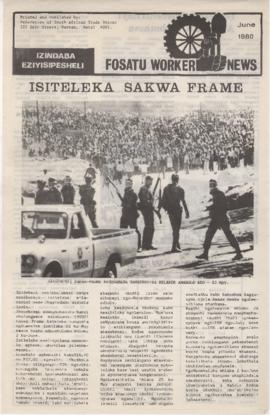Zone d'identification
Cote
Titre
Date(s)
- 1979 - 1985 (Production)
Niveau de description
collection
Étendue matérielle et support
Form of materialNewsletter publication
Zone du contexte
Nom du producteur
Histoire administrative
The formation of FOSATU was part of the fight to organise workers in South Africa into independent, non-racial trade unions. The first effective trade union organising black workers was formed in 1917 and was followed by the ICU (Industrial and Commercial Workers Union) in 1919. The 1950s saw the emergence of SACTU (South African Congress of Trade Unions) and the upsurge of political and worker' organisation. Slate repression led to the 1960s being a low point of worker organisation.
The 1970s were a time of great challenge for the labour movement in South Africa. Workers were experiencing growing hardships and poverty due to unemployment and inflation and as a consequence worker militancy was rapidly on the rise. As a result of the Wiehahn Commission new industrial legislation was being prepared which would bring important changes in industrial relations and worker organisations were becoming increasingly important in politics and the economy. In the face of growing opposition from the State, from employers and from the established unions (i.e. racist white unions and TUCSA) the need for greater unity was clear and new trade union bodies began to emerge countrywide.
Exploratory talks on a united Labour federation were initiated by the National Union of Motor Assembly and Rubber Workers of South Africa (NUMARWOSA) in early 1977. These talks lead to the formation of a Feasibility Committee. Participants in this committee were the four affiliates of the Trade Union Advisory and Co-ordinating Council (TUACC), NUMARWOSA, the United Automobile Workers (UAW), and three unions that broke from the Transvaal Consultative Committee of Black Trade Unions. FOSATU emerged two years later as a result.
It was a basic commitment to worker participation, opposition to racism and the desire to pool limited resources and skills that brought unions together in FOSATU. The inaugural congress of FOSATU was held in April 1979 at Hammanskraal near Pretoria. The 150 delegates elected UAW'S John Mike as President and TUACC's Alec Erwin as General Secretary. There were twelve affiliates present, three registered and nine unregistered, claiming a membership of 45 000. FOSATU became the first federation of predominantly unregistered trade unions to operate openly in South Africa since the suppression of SACTU in the 1960s
FOSATU's main objective was to build a strong national, non-racial, independent, worker controlled labour movement firmly located in the factories with strong shop-floor structures. It also committed itself to an ongoing worker education programme and to decent standards of living and fair working conditions. It did not align itself with any party political organisation and opposed attempts by such organisations to control FOSATU or its affiliates. It spent most of its energy on organising, on negotiating recognition agreements with management, and on bargaining over wages and working conditions. This cautious policy on union involvement in political activities was rooted within the framework of state repression against unions after the 1973 Durban strikes and the 1976 Soweto uprising.
The highest policy making body was the National Congress. When the National Congress was not meeting management of the Federation was vested in the Central Committee. Between meetings of the Central Committee the Executive Committee carried out the day to day administration of the Federation. Regional Councils were established to encourage unions to work together on the ground and affiliate branches were represented on it. FOSATU also encouraged affiliates to set up local offices of their unions to facilitate closer liaison between the unions
The major criticism against FOSATU was that its leadership was elite and that decisions were taken by a few officials only. Initially FOSATU unions were not necessarily democratic but as it grew and began to develop a unique uniform strategy the worker leaders began to exercise more control and the officials lost much of their power.
By 1982, with a membership of 105 000, FOSATU could no longer ignore community politics and it began to take up political issues. In 1983 the need for a wider alliance and for union unity was addressed. A Feasibility Committee was set up to discuss the formation of a new federation and in 1984 talks. Representing about 300 000 workers from the major black unions in key manufacturing, commercial and mining sectors, were held. The Congress of South African Trade Unions (COSATU) emerged in November 1985 as a result of these talks.
During its existence (1979-1985) FOSATU achieved significant gains. The lot of workers had improved via increased wages, the acknowledgement of workers rights in approximately 400 factories, and better conditions on the factory-floor. Apart from these achievements FOSATU played a vital part in the growth of an independent worker culture.
Histoire archivistique
Source immédiate d'acquisition ou de transfert
Zone du contenu et de la structure
Portée et contenu
Newsletter publication of the Federation of South African Trade Unions between 1979-1985.
Also refer to collections AH1999 Federation of South African Trade Unions (FOSATU); AH2065 Taffy Adler and A2168 Jane Barrett.



